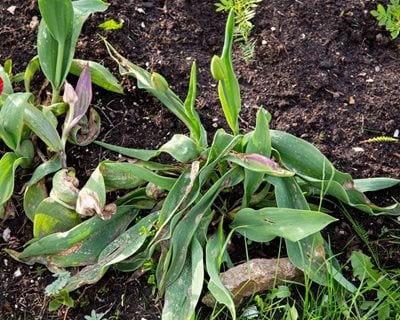Botrytis: How to Treat & Prevent Gray Mold
Learn how to identify gray mold and get advice for keeping it out of your garden.
Botrytis blight on roses. Photo by Valeriana Y / Shutterstock.com
Few things are more distressing than walking into your garden and discovering a fuzzy gray mold growing all over your plants. This nasty looking fungal disease, known as botrytis blight, can attack the buds, flowers, leaves, bulbs, and fruit of a variety of ornamental and edible plants. Once it takes hold, botrytis blight can be hard to eradicate because it spreads among plants quickly and can cause significant damage.
Because prevention is much easier than trying to deal with botrytis after an infection, it’s important to know what causes gray mold, the plants that are most susceptible, and the conditions that can facilitate its growth and spread.
HOW TO IDENTIFY BOTRYTIS BLIGHT
The telltale signs of botrytis blight can differ depending on the part of the plant it targets. The most common symptoms to look for include:
- Brown to gray circular spots on leaves, stems, and petals.
- Flower buds that develop abnormally and turn brown.
- Fuzzy silvery-gray growth on flowers, fruit or foliage, especially after a period of cool, wet weather.
- Wilting or decaying leaves.
- Darkened, slightly sunken areas (called cankers) on plant stems.
- The appearance of soft rot on corms and bulbs.
Some species of Botrytis form sclerotia (small, black, hardened fungal masses) on the surface of diseased plant tissue. Sclerotia are particularly troublesome because they can overwinter in the soil and survive changing environmental conditions.
CONTROL & TREATMENT OF BOTRYTIS
If a gray mold infection breaks out in your garden, the most effective control method is to promptly prune off diseased portions of the plant (or remove the entire plant if fully infected) and place them in a bag for disposal. Don’t compost infected plants because the spores can remain active. Also be sure to sterilize your pruners with a disinfectant after every use to prevent spread of the fungus to healthy plants (see Tool Care & Maintenance).
If you’ve had problems with gray mold in the past, you can apply a chemical fungicide to your plant before symptoms appear to prevent an outbreak from developing. Since these chemicals will not stop an established infection, they should only be used as a preventive measure. Look for products with active ingredients such as chlorothalonil, captan, iprodione, thiophanate-methyl, or mancozeb
If you want to avoid the use of chemicals, sprays containing neem oil extract can be used as a natural preemptive measure to prevent botrytis blight and other fungal and bacterial diseases. You can also treat your plants regularly with an organic fungicide that contains sulfur or copper as the active ingredient.

Botrytis blight (gray mold) on strawberries. Photo by Floki / Shutterstock.com
HOW TO PREVENT GRAY MOLD
Although you can’t prevent the cool, damp weather conditions that foster the development of gray mold, there are steps you can take to limit its growth and spread. Many of these same strategies will also help prevent other fungal diseases in the garden, such as powdery mildew.
- Promote good airflow by providing adequate spacing between plants and by thinning out plants that have become too dense.
- Because standing water on plants, especially in the presence of high humidity, creates an ideal environment for gray mold, avoid overhead watering by using a drip irrigation system. Also water in the morning so any moisture that gets on the foliage has a chance to dry under the sun’s rays.
- Practice good housekeeping by keeping the soil around your plants free of debris, such as dead leaves, spent flower petals, and fallen fruit. Botrytis likes to feed on decayed plant matter, so removing it from your garden will reduce the risk of an infection.
- Avoid injury to your plants when handling, pruning, or transplanting. Gray mold often starts on wounded plant tissue.
- Because Botrytis can overwinter in the soil as sclerotia, be sure to remove plant debris from your garden every fall, especially if you’ve had a gray mold outbreak.
HOW DOES GRAY MOLD SPREAD?
Once you have a gray mold infection, the microscopic spores produced by the fungus can easily move from plant to plant. Not only are they readily windborne, they can also hitch a ride on water droplets, infected plant materials, and pruning tools (unless disinfected).
When Botrytis overwinters in the soil or on plant debris as sclerotia, the fungus can be spread around the garden through activities such as digging, hoeing, or raking. In the spring, when the sclerotia germinate, they will produce more spores that can infect vulnerable flowers and foliage in their path.
WHAT ARE THE IDEAL CONDITIONS FOR GRAY MOLD?
Gray mold thrives in wet, humid, and cool conditions (60º to 75º F). That’s why it more commonly occurs in the spring, when rainfall is more abundant and temperatures are cooler. What gray mold doesn’t like is heat. During the summer when temperatures soar above 80º F, its development will slow or stop altogether.
A greenhouse also provides the perfect breeding ground for gray mold, which is why you may discover it on greenhouse-grown ornamental and vegetable plants after you bring them home. It’s wise to hold off on putting new plants in your garden until you can confirm through a visual inspection that they are botrytis-free.

Botrytis blight on tulips (Botrytis tulipae). Photo by Valeriana Y / Shutterstock.com
WHAT PLANTS ARE SUSCEPTIBLE?
Fungi in the genus Botrytis can infect many different hosts. The most common, Botrytis cinerea, feeds on over 200 species of plants, including many garden annuals, perennials, shrubs, vegetables, berries, and other soft fruit. Some species of Botrytis target a specific plant, such as lilies (Botrytis elliptica), peonies (Botrytis paeoniae), and tulips (Botrytis tulipae).
Other flowering plants vulnerable to gray mold include begonias, chrysanthemums, cyclamen, geraniums, dahlias, impatiens, marigolds, roses, and sunflowers. In the vegetable garden, be on the lookout for gray mold growing on tomatoes, peppers, lettuce, beans, potatoes, and cabbage.
Note that gray mold can affect any part of a plant, with the exception of the roots, so you need to be vigilant and inspect your plants carefully. Most often you’ll find it growing on damaged, diseased, or delicate plant tissue.
RELATED:
Black Spot on Roses
Pests, Diseases, and Other Garden Problems

